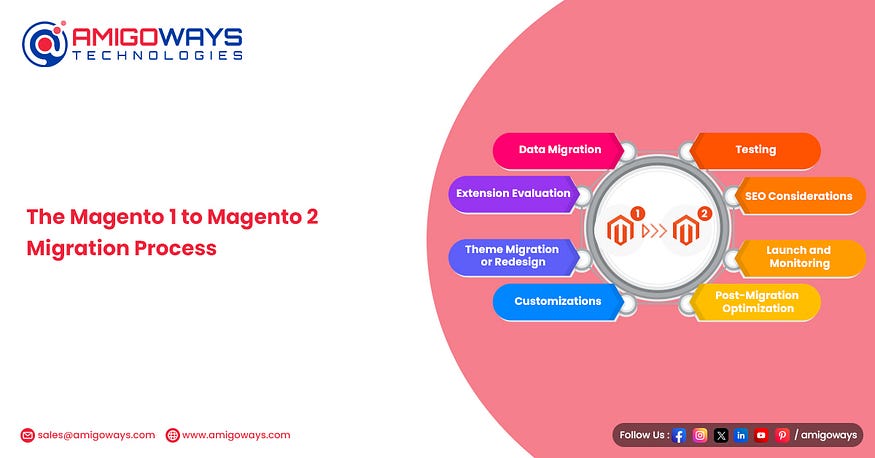In the fast-paced world of e-commerce, staying up to date with the latest technologies and trends is crucial for the sustained success of your online store. If you’re currently running your store on Magento 1, it’s high time to consider migrating to Magento 2. This migration is not just a simple upgrade; it’s a major leap that can bring your online business to a new level of performance, security, and functionality. In this comprehensive guide, we’ll walk you through the steps of a successful Magento 1 to Magento 2 migration.
Why Migrate from Magento 1 to Magento 2?

1. End of Support
Magento officially ended support for Magento 1 in June 2020. This means no more security patches, updates, or official support. As a result, your Magento 1 store becomes increasingly vulnerable to security threats.
2. Improved Performance
Magento 2 is significantly faster and more efficient than its predecessor. With improved indexing and caching mechanisms, your site will load faster, leading to a better user experience.
3. Enhanced Security
With ongoing support and updates, Magento 2 provides a more secure environment for your e-commerce store. This is crucial in a world where data breaches and cyber threats are on the rise.
4. Mobile Optimization
Magento 2 is built with mobile optimization in mind. As mobile shopping continues to grow, this is a critical factor for success in e-commerce.
5. Advanced Features
Magento 2 offers new features and functionalities that can help improve customer experience and streamline your operations, such as improved checkout processes and a user-friendly admin panel.
Now that you understand the importance of migrating to Magento 2 let’s dive into the migration process.
The Magento 1 to Magento 2 Migration Process

1. Data Migration
The first step is to migrate your data. This includes customer information, product catalogs, sales data, and more. Magento provides data migration tools to assist in this process. Make sure to clean and optimize your data before migration to avoid transferring unnecessary clutter.
2. Extension Evaluation
Not all Magento 1 extensions are compatible with Magento 2. You’ll need to evaluate your current extensions and either find Magento 2 equivalents or custom-develop solutions. Magento’s marketplace offers a wide range of Magento 2 extensions.
3. Theme Migration or Redesign
You can either migrate your existing Magento 1 theme to Magento 2 or take this opportunity to revamp your site’s design. A responsive and mobile-friendly design is a must for Magento 2.
4. Customizations
If you have custom code, scripts, or integrations, you’ll need to re-implement them for Magento 2. Make a detailed inventory of all customizations, so nothing is left out during the migration process.
5. Testing
Thoroughly test your migrated store to ensure everything is working as expected. Test functionality, compatibility, and performance. Address any issues that arise.
6. SEO Considerations
Don’t forget to update your SEO settings, URLs, and meta information. Proper 301 redirects are crucial to maintain search engine rankings.
7. Launch and Monitoring
Once you’re confident that everything is in order, it’s time to launch your new Magento 2 store. Monitor the site closely during the initial post-launch phase to catch any unexpected issues.
8. Post-Migration Optimization
After your site is live, continue to monitor its performance, gather user feedback, and make necessary optimizations to ensure it’s running smoothly.
Common Challenges and Tips

Backup Everything: Always have a complete backup of your Magento 1 site and database before starting the migration process.
Engage Professionals: If you’re not confident in your technical abilities, it’s highly recommended to work with experienced Magento developers who specialize in migrations.
Keep Customers Informed: Inform your customers about the migration and any potential downtime. Make sure they are aware of the improvements they can expect.
Educate Your Team: If you have an in-house team, make sure they are familiar with Magento 2’s features and functionalities.
Conclusion
Migrating from Magento 1 to Magento 2 is a significant undertaking, but the benefits in terms of performance, security, and feature enhancements are well worth it. Plan your migration carefully, ensure data integrity, and stay up to date with best practices. With proper preparation and execution, your online store can thrive in the Magento 2 environment, providing an enhanced shopping experience for your customers and greater success for your e-commerce business.
In the ever-evolving world of e-commerce, the decision to migrate from Magento 1 to Magento 2 is a pivotal one. It’s a journey that promises improved performance, security, and a wealth of enhanced features to elevate your online business. As you embark on this migration, remember that having the right team of experts and partners is crucial to its success. When it comes to Magento development services, companies like Amigoways, with their dedicated team of professionals, offer end-to-end solutions that can help you navigate the intricacies of this transition seamlessly. So, embrace this opportunity for growth, set your business brand on a global stage with Magento 2, and with the right partners by your side, your e-commerce venture can flourish like never before.
Get expert insights and tips for a seamless transition — https://www.amigoways.com/blog/magento-1-to-magento-2-migration-guide/

